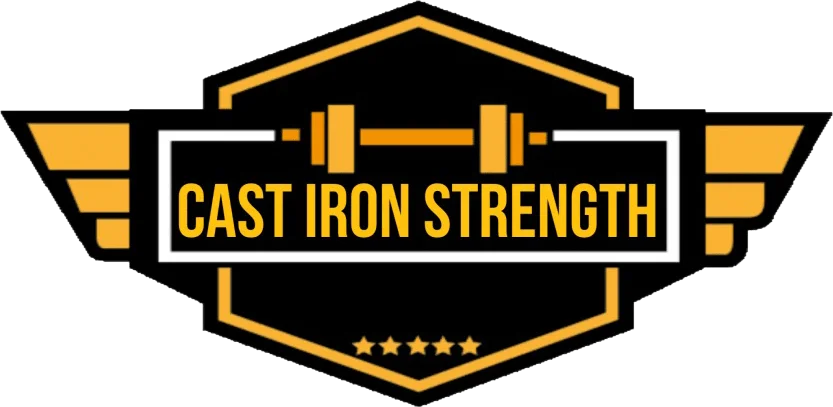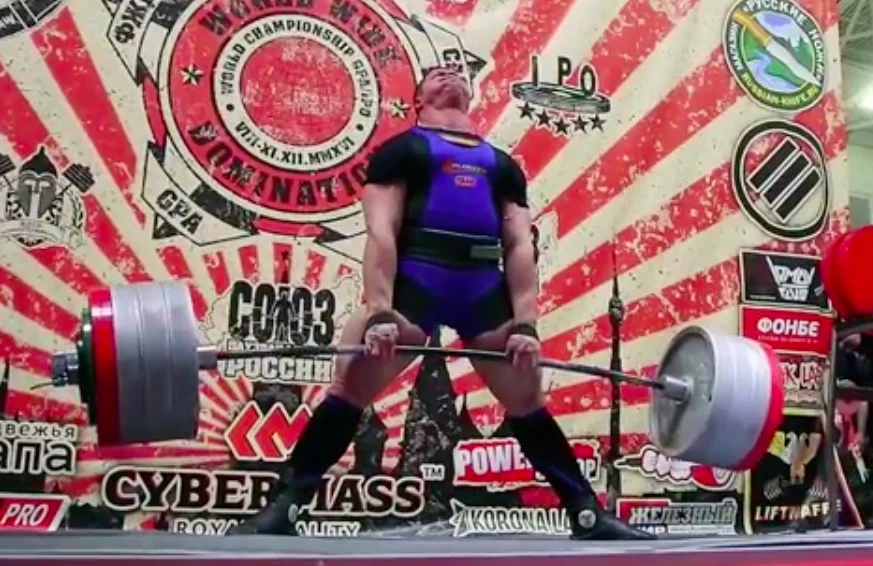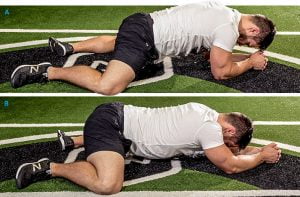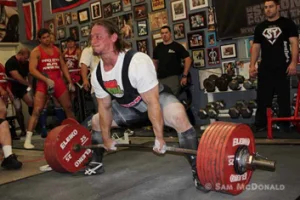Put on your Druids hat, stand in a chalk fairy circle on the platform and get ready to perform some Magick that will turn your stinky “wide stance conventional” deadlift into something more pleasing to the Elder Gods.
In this article, I’ll be covering how to move from pulling conventional to having the basics of a good sumo set up in place. Whether you chose to do this as a backoff lift, a variation away from competition or just a personal challenge to show your Insta followers how wide you can spread your hips is up to you; I won’t be covering programming or small details, just the broad strokes. If you’re already Sumo proficient, you might get a few little tips out of this, and if you are thinking of coming over to the Sumo side of the force for the first time it will save you months of heartache.
I’m going to kick this off with a video showing “Before” and “After” with a lifter (Yandra) who learned sumo by herself, then came in for a one-off session to sort out the mess. The “After” is by no means the finished article, it just shows the progression in a single session.
The main differences are in the relative angles of the limbs and torso at the start position, which are roughly as follows (“Before” angles first, “After” angles second)
Floor to Shin : 67 degrees Vs 79 degrees
Shin to femur: 80 degrees for both
Femur to Torso: 71 degrees Vs 73 degrees
Torso to floor : 40 degrees Vs 52 degrees.
In the starting position, to get from “before” to “after” stick figure Yandra would “hinge” back and down at the hips, bringing the angle of the shin closer to vertical. This was mostly accomplished by teaching Yandra the correct way to set her foot position and drop to the bar. The net effect is that the stick figure is now more “behind” the barbell than in front, and the combined centre of mass of figure and barbell is over the middle / rear of the foot rather than the ball of the foot. Yandra’s hips are also now much closer to the bar bell at the start of the lift, as her knees are more splayed out to the sides. The main “gain” from all this is that in the “before” deadlift the bar travels 52cm, and in the “after” it travels 33cm. As Yandra gets the timing of the movement better, the bar will also move in a more vertical path this way. So we end up with a shorter, straighter, pull which is more mechanically efficient and creates the potential (in time) to lift greater weight.
So, that’s what’s different, but how to do it?
1 – Stretch.
There’s a shit ton of funky looking “mobility drills” out there for hips, hamstrings, groins ankles and so forth and I don’t particularly want to add to the pile or be overly prescriptive. The bottom line is that most people, who can’t pull sumo properly, can’t get in to a decent start position. They can’t do this because they are not flexible enough, and they are not flexible enough because they don’t put in the time to become more flexible. See for yourself by simply trying to set up in a “nice” position. What hurts? What’s tight? What’s stopping you getting your hips low enough? Close enough to the bar? Why is your entire back rounded? Deduce what is stopping you getting set right, and address it with whatever stretches / drills hit the spot for you.
I have a fairly mangled left SI joint, some grumbly discs, a disagreeable QL, a left glute that is made out of bricks and paper mache, poor pec / shoulder mobility, tight hip flexors, poor upper back mobility and so on. Which is another way of saying I have exactly the “normal” issues for someone who strength trained for years and has a desk based job. It’s also why I have chosen to pull sumo! My lower back is fucked (technical Powerlifting term there!) and sumo forces me to address the underlying reasons why instead of pretending they don’t exist until it is snap city time again.
If I approach the bar stone cold and try to set up to pull Sumo, it looks just as awful as the majority of newly qualified PT’s efforts. It currently takes me about 30 minutes of work before I can get to the bar correctly. That’s down from almost an hour when I first started. My early sessions went like this…
General warmup.
25 minutes or so stretching, mobility drills, glute activation stuff etc.
Sumo – Pull a light single. Review video. See that it was still shit.
25 minutes or so more stretching.
Sumo – Pull 5-10 singles at a moderate load. Review each one and improve whatever sucked.
“Glass floor” sumo – do a few sets of 6-10 reps with about 50% of the weight I Pulled the singles with, both concentric and eccentric very controlled, allowing plates to just contact the floor whilst maintaining position then pulling the next rep.
Back extensions, rear delts – couple sets each.
Random assortment of high rep glute work – 20 minutes or so.
Cry about my groin being sore x 10.
I’d do that 3 times a week. Now it takes a bit less time to get to the bar and my routine has coalesced to a few less stretches / drills that give me the most bang for the buck, but I still have no hope of approaching the bar stone cold and pulling well.
What YOU need to do might be totally different from me, but the point is that you HAVE to address the reasons why your set up isn’t good enough if you are going to progress.
As you go through the following set up points, if at any time you can’t get in to the position, note it, stretch it, and try again.
2 – Get your feet out. Wide AND flared.
I’m 6 foot 1 and the damn bar just isn’t wide enough for me to put my feet where I’d really like to. Get your feet out as wide as you can. Your toes will be well outside your heels, go for about 40 degrees relative to the barbell as a starting point. Once you get to (3) and start opening the groin up, your knees should line up with your toes when the groin is as “open” as it can get. Almost everyone who tries sumo initially starts with their stance just outside of conventional, and there feet pointing too forward, which in turn stops them from…
3 – Bending at the knee by opening the groin to sink the hips straight down.
In the conventional deadlift your hips will be a fair bit from the bar. In sumo, I’d advocate trying to keep your hips as close as possible to the bar. This won’t reduce the amount of hip extension required to complete the lift (it just changes the plane of movement), but it WILL reduce the load on the lower back by giving you are more upright torso. To do this set your feet nice and wide and then attempt to get down towards the bar solely by opening your groin, pushing each thigh out as close to parallel to the barbell as possible and bending the knee such that the hip don’t drift back at all. I like to imagine I’m setting up in a really narrow corridor, with a wall behind me and a wall in front. I first read this cue in a Boris Sheiko article, so you can say it’s wrong, but you’d be wrong. I don’t like appeals to authority, but I am firmly on the side of Sheiko exceptionalism in this case. Anyway, I’m not allowed to touch the walls with either my butt or my nose. When coaching this I’ll often make inventive use of carefully placed broom sticks to errrr, drive the point home, or put a pulling block behind the lifter and tell them they are not allowed to touch it with their butt, and another in front of the bar that they can’t touch with their head or chest. Remember, you aim is to keep the hips as close to the bar as you can and bend the knees outward, NOT push the knee or lean the torso forward over the bar.
Can you get to the bar? Or do you get so far and then fold forward, shove your ass back and end up in some kind of semi-sumo-stiff-legged-round backed nightmare? If you do find there’s a limit beyond which you can’t keep the torso upright, what feels “tight” at the limit point? Groin? Glutes? The funny bit that’s neither your ass nor your hamstring? Whatever it is, go stretch it, roll it, attack it with a golf ball, hang upside down like a bat from a band in the power rack or whatever else you need to do to get it to co-operate and then try again.
4 – Make your arms long.
Whilst dropping down to the bar, REACH downwards. Extends your arms as long as you can without rounding your upper back. Open your elbows fully, get your biceps to feel stretched. Push your shoulder girdle down in to the torso. You know that bit in every 80’s action flick where the hero and his bestest chum in the whole wide world are reaching for each others hands, while bestest-chum hangs off a building, or a cliff edge, or whatever? There are beads of sweat on their brows, their entire beings are focused in to stretching their arms as long as they can, there’s some dramatic music playing in the background and so forth? That’s you, reaching for the bar. Don’t drop your hips any deeper than you need to in order to set your grip, you are going to dip them a little lower when you go to start the pull.
5 – Assuming you can grab the bar…
Set your grip as “high” as you can. Open palm rather than closed. Monkey grip in the fingertips if you can hold on to a heavy pull that way. I use an open palm hook grip and advocate the same to most people. With no rotational stress, no bicep tears, and just a bit of thumb pain to put up with for a while as the “downside”, a hook grip makes good sense for the majority of lifters. Monkey grip double overhand would best of all (as it makes the arm as long as possible and reduces ROM the most) but it’s rare to find a lifter who has the strength to grip big weight this way. Whatever your grip, make the arm and hand as long as possible along the way.
6 – Arch your feet.
Once you’ve got to the bar and set your grip, bridge your feet in to the highest arch possible. Some lifters will benefit from thinking about pulling their heels towards one another at this point to. You’ll notice your knees will flare out another centimetre or several and the bar will probably now be “too far away”. Keep arching hard on the feet, flare the knees wider still, pull the hips as close to the bar as you can and then roll the bar back in towards your foot till it’s placed such your arms hangs vertically again, straight down to the bar. Now stand up and note where the bar is relative to your feet – is it over the last shoelace? Touching the inside of the ankles below the calves? Just pay attention to where it is and set your feet there next time, then when you descend to the bar next time, “arch up” with your feet as you drop your hips straight down towards the bar – you find yourself in the right position just in time to…
7 – Take the slack out of the bar.
Once your feet are arched and your knees are as wide as they are going to get, keep the arms absolutely straight and, the shoulder blades down and then squeeze the middle and upper back, back and down to slightly lift the sternum up, spreading the chest as open as possible, whilst allowing the hips to drop a little. In doing so the bar should lift a millimetre or so and be “tight” against the top of the holes in the plates. Done correctly, you’ll feel the tension / loading come on to the legs as the hips drop and the torso “screws in” towards the bar and becomes more upright. From there, any upward motion of your body created by straightening the knees should cause the plates to rise also. Or cause the bar to bend and the plates to stay put if you’re using a whippy bar and enough weight! Regardless, there should never be a “clunk” or a sudden “yank” on the bar, the loading should be apparent on the legs before you initiate the actual pull. This might only take a fraction of a second to do, it needn’t be an obviously separate part of the set up, but it has to happen BEFORE you really attack the bar with the legs. Some lifters dip, take out the slack, and then begin the pull in one motion; others are slower and more deliberate about it. Neither way is intrinsically right or wrong, just make sure there’s no slack in the set up.
8 – Start to straighten your knees.
Getting into position for Sumo is a matter of bending the knee whilst pushing the thighs out as close to parallel to the bar as you can. The first part of the pull is simply a matter of straightening the knee joint whilst keeping the hip externally rotated and the thigh pointing out along the bar. Torso angle should remain almost exactly the same throughout this part. If you feel your knees buckling inwards and your torso leaning forward as you try and break the bar from the floor, reduce the load and direct your assistance work towards building some more strength (in all directions but especially adduction and external rotation) around the hips and in your quads. Or just keep the load where you can handle it and up the volume of correctly performed sumo deadlift’s to build the strength directly. The knees will almost completely straighten BEFORE there is any attempt to pull back on the bar. For most lifters this will leave the bar well above the knee, with the torso angle almost exactly the same as it was when the bar left the floor. A good test and assistance exercise is the sumo deadlift to knee height; essentially just this first pull followed by a reversal back down to the floor. Do it very light and try and get the “feel” of the torso remaining static, with the head and hips in exactly the same position with bar on the floor and bar on the knee. Do this up and down for several reps, keeping the torso static on both concentric (easy-ish) and eccentric (harder). Watch it back and see if your torso angle changes. I like to envisage the upper body as being a single unit that gets moved vertically up and down at that fixed angle by my legs. I say legs, in my head they are actually cartoon mechanical pistons that even have their own 80’s-tastic sound effects but you don’t actually need to be that fucked in the brain to pull sumo. It helps though.
9 – Lockout by…. Oh wait, you’ve already lockout out.
Seriously, if you have worked on getting positions right it should astonish you how short the bar travel really is and you should “done” before you know it. That said once you get in to heavier weight you will have to work to lockout at the top. The worst advice I’ve had here is to “push the hips through”. Push them through from where? If you’ve got an upright enough torso at the start and then straightened the knee whilst maintaining both the torso angle the same and the groin “open”, then the hips will already be close to extension. By all means squeeze your ass but don’t think of your pull as being “up” in a straight line then “hips through”. That will lead you to leave your hips back at the set up so you can ram them forward half way up; turning all that hard work back in to a bastardised wide stance conventional pull. Instead think about pulling back from the mid-back. The middle traps and rhomboids squeeze back and down, and you lean back a LITTLE, lift the sternum and tuck the chin down to counterbalance the tendency to tip to the rear. Ta Da! You’ve locked out. If you time the “pull” from the back correctly, you should be able to accelerate the bar straight through to lockout. If you are late in pulling back on the bar and instead try to push the hips right through you before pulling back you will often find you stall out in the last 2-3 inches of the lift.
Little things…
- Cut your nails. If you hook then your grip can be pulled open by your finger nails catching the skin of your legs and whilst there’s nothing more badass than finishing a set with blood streaming down your legs it’s not good for the next lifter to the bar and if there’s enough claret flowing you’ll find maintaining your grip even harder on subsequent reps. So sacrifice the manicured look and trim them short.
- Talc everything. – There’s a lot of bar contact when Sumo is done right. Talc will reduce friction between bar and body, so go ahead and talc your thighs etc before heavy attempts. Just do it the fuck away from the platform or any area where someone will be lifting.
- A good partial ROM lift is better than a crappy full ROM lift. If you can’t get in a good shape from the floor due to being a bit tight, then it’s better to work with the right shape from low blocks or a couple of mats whilst you improve your flexibility than to make a bollocks of your pulls and hope the flexibility eventually catches up.
- Assistance exercises need to actually assist. Try and be analytical about where you are weak and chose your assistance exercises accordingly. Think not just in terms of what muscles are working, but in what planes and at what angles, what their role in the lift is (Fixating? Rotating? Extending a joint?) and then train towards that specific function. As a result of that thinking, some of my own exercises look, well, weird or at least atypical. That’s cool. Better that than doing purposeless work.
- Normalise proper sumo! Sumo is still regarded as being the “odd” way to deadlift, at least here in the UK. Seeing as we pretty regularly get our asses handed to ourselves by more sumo-friendly nations it’s long overdue to Sumo to become “just another lift”. I’ve jokingly referred to it being some kind of strange magic many times, but in truth, it’s just a lift like any other. Demystified and taught simply it is often a better choice than conventional for MANY lifters. So, next time you are asked to teach a newb to deadlift, break the mold and try teaching them sumo first.
Gavin Laird is a gym owner, Powerlifting and strength coach based in Inverness, Scotland. For 20 years he has worked with individual clients and sports teams at all levels to improve their strength for a variety of sports. Since returning to coaching Powerlifters in 2013 Gavin’s lifters have broken over 80 Scottish records, several British records and have represented Scotland or GB at the IPF Commonwealth, European and World championships and GPC European and World championships Members of his Forge Gym have also won Scotland’s Strongest Man (5 years running), Scotland’s Natural Strongest Man (2017) and competed at World’s Strongest Man. In 2016 Gavin was awarded the SportScotland Highland “High-Performance Coach of the Year” award.
Outside of Coaching and running the gym Gavin designs and manufactures gym equipment and develops the R-INOL system of monitoring training load.
You can contact The Forge Gym at https://www.facebook.com/ForgeGym/
Highland Barbell Club at https://www.facebook.com/HighlandBarbellClub/
And for coaching enquiries (1-1 only, no online coaching!) contact Gavin at





















